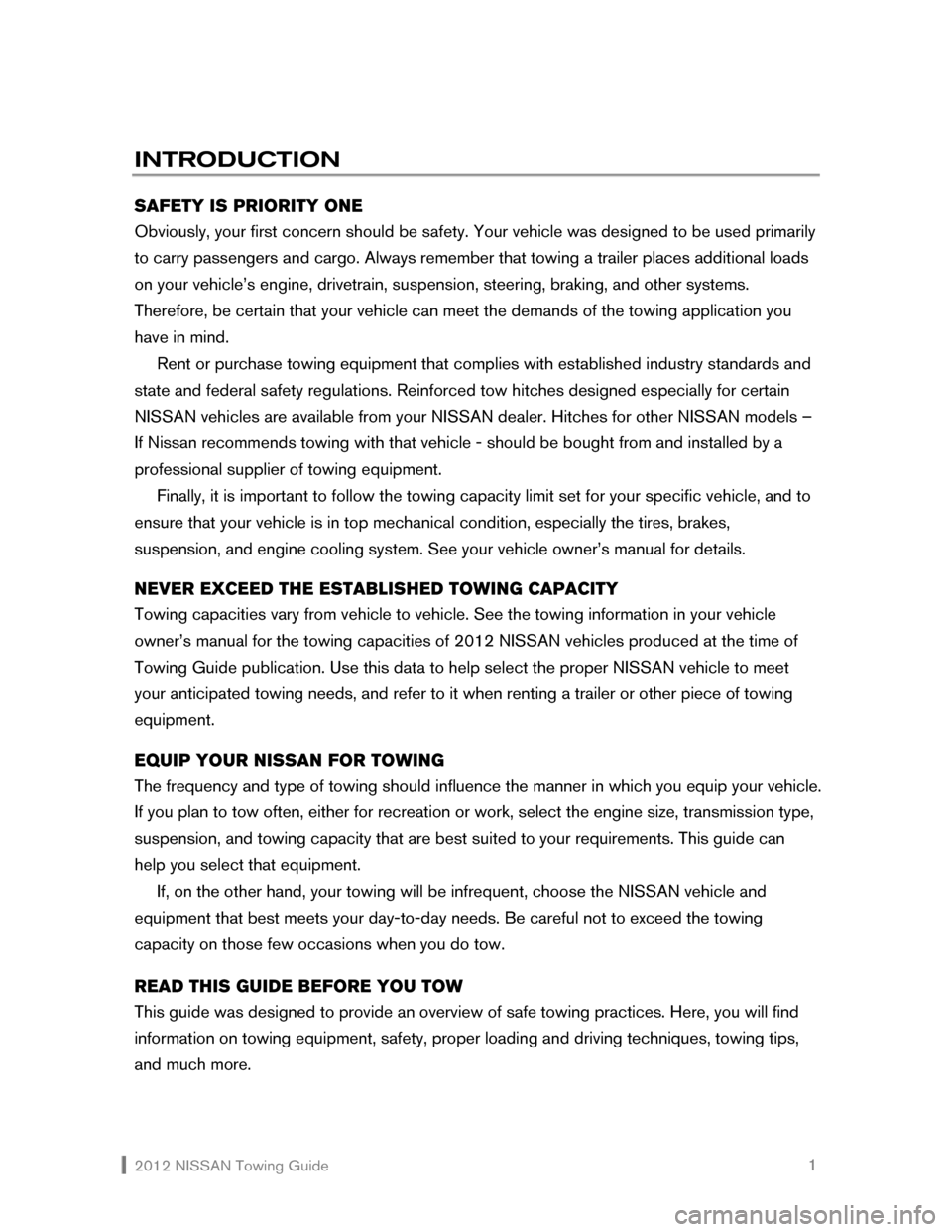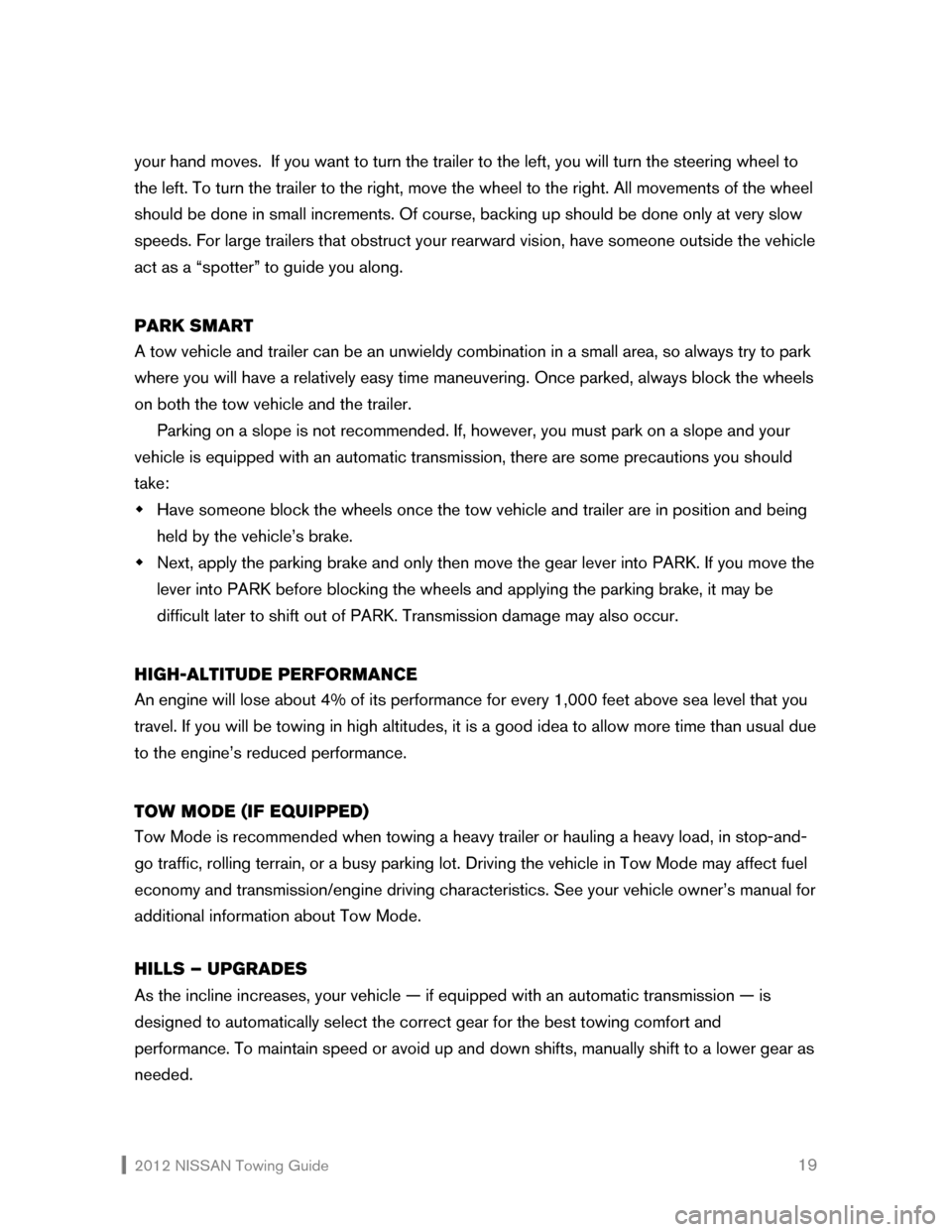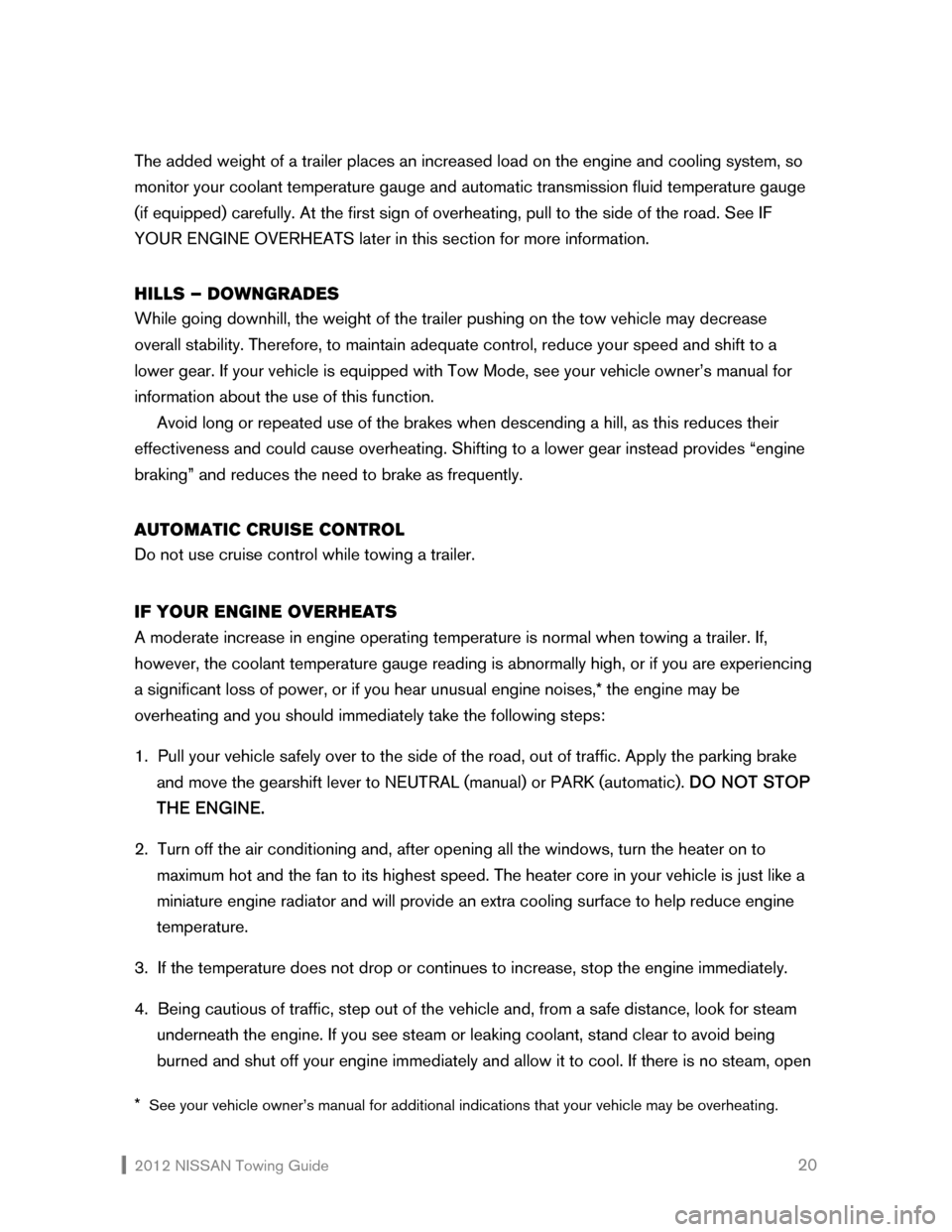2012 NISSAN QUEST manual transmission
[x] Cancel search: manual transmissionPage 2 of 27

2012 NISSAN Towing Guide 1
INTRODUCTION
SAFETY IS PRIORITY ONE
Obviously, your first concern should be safety. Your vehicle was designed to be used primarily
to carry passengers and cargo. Always remember that towing a trailer places additional loads
on your vehicle’s engine, drivetrain, suspension, steering, braking, and other systems.
Therefore, be certain that your vehicle can meet the demands of the towing application you
have in mind.
Rent or purchase towing equipment that complies with established industry standards and
state and federal safety regulations. Reinforced tow hitches designed especially for certain
NISSAN vehicles are available from your NISSAN dealer. Hitches for other NISSAN models –
If Nissan recommends towing with that vehicle - should be bought from and installed by a
professional supplier of towing equipment.
Finally, it is important to follow the towing capacity limit set for your specific vehicle, and to
ensure that your vehicle is in top mechanical condition, especially the tires, brakes,
suspension, and engine cooling system. See your vehicle owner’s manual for details.
NEVER EXCEED THE ESTABLISHED TOWING CAPACITY
Towing capacities vary from vehicle to vehicle. See the towing information in your vehicle
owner’s manual for the towing capacities of 2012 NISSAN vehicles produced at the time of
Towing Guide publication. Use this data to help select the proper NISSAN vehicle to meet
your anticipated towing needs, and refer to it when renting a trailer or other piece of towing
equipment.
EQUIP YOUR NISSAN FOR TOWING
The frequency and type of towing should influence the manner in which you equip your vehicle.
If you plan to tow often, either for recreation or work, select the engine size, transmission type,
suspension, and towing capacity that are best suited to your requirements. This guide can
help you select that equipment.
If, on the other hand, your towing will be infrequent, choose the NISSAN vehicle and
equipment that best meets your day-to-day needs. Be careful not to exceed the towing
capacity on those few occasions when you do tow.
READ THIS GUIDE BEFORE YOU TOW
This guide was designed to provide an overview of safe towing practices. Here, you will find
information on towing equipment, safety, proper loading and driving techniques, towing tips,
and much more.
Page 20 of 27

2012 NISSAN Towing Guide 19 your hand moves. If you want to turn the trailer to the left, you will turn the steering wheel to
the left. To turn the trailer to the right, move the wheel to the right. All movements of the wheel
should be done in small increments. Of course, backing up should be done only at very slow
speeds. For large trailers that obstruct your rearward vision, have someone outside the vehicle
act as a “spotter” to guide you along.
PARK SMART
A tow vehicle and trailer can be an unwieldy combination in a small area, so always try to park
where you will have a relatively easy time maneuvering. Once parked, always block the wheels
on both the tow vehicle and the trailer.
Parking on a slope is not recommended. If, however, you must park on a slope and your
vehicle is equipped with an automatic transmission, there are some precautions you should
take:
�Š Have someone block the wheels once the tow vehicle and trailer are in position and being
held by the vehicle’s brake.
�Š Next, apply the parking brake and only then move the gear lever into PARK. If you move the
lever into PARK before blocking the wheels and applying the parking brake, it may be
difficult later to shift out of PARK. Transmission damage may also occur.
HIGH-ALTITUDE PERFORMANCE
An engine will lose about 4% of its performance for every 1,000 feet above sea level that you
travel. If you will be towing in high altitudes, it is a good idea to allow more time than usual due
to the engine’s reduced performance.
TOW MODE (IF EQUIPPED)
Tow Mode is recommended when towing a heavy trailer or hauling a heavy load, in stop-and-
go traffic, rolling terrain, or a busy parking lot. Driving the vehicle in Tow Mode may affect fuel
economy and transmission/engine driving characteristics. See your vehicle owner’s manual for
additional information about Tow Mode.
HILLS – UPGRADES
As the incline increases, your vehicle — if equipped with an automatic transmission — is
designed to automatically select the correct gear for the best towing comfort and
performance. To maintain speed or avoid up and down shifts, manually shift to a lower gear as
needed.
Page 21 of 27

2012 NISSAN Towing Guide 20 The added weight of a trailer places an increased load on the engine and cooling system, so
monitor your coolant temperature gauge and automatic transmission fluid temperature gauge
(if equipped) carefully. At the first sign of overheating, pull to the side of the road. See IF
YOUR ENGINE OVERHEATS later in this section for more information.
HILLS – DOWNGRADES
While going downhill, the weight of the trailer pushing on the tow vehicle may decrease
overall stability. Therefore, to maintain adequate control, reduce your speed and shift to a
lower gear. If your vehicle is equipped with Tow Mode, see your vehicle owner’s manual for
information about the use of this function.
Avoid long or repeated use of the brakes when descending a hill, as this reduces their
effectiveness and could cause overheating. Shifting to a lower gear instead provides “engine
braking” and reduces the need to brake as frequently.
AUTOMATIC CRUISE CONTROL
Do not use cruise control while towing a trailer.
IF YOUR ENGINE OVERHEATS
A moderate increase in engine operating temperature is normal when towing a trailer. If,
however, the coolant temperature gauge reading is abnormally high, or if you are experiencing
a significant loss of power, or if you hear unusual engine noises,* the engine may be
overheating and you should immediately take the following steps:
1. Pull your vehicle safely over to the side of the road, out of traffic. Apply the parking brake
and move the gearshift lever to NEUTRAL (manual) or PARK (automatic). DO NOT STOP
THE ENGINE.
2. Turn off the air conditioning and, after opening all the windows, turn the heater on to
maximum hot and the fan to its highest speed. The heater core in your vehicle is just like a
miniature engine radiator and will provide an extra cooling surface to help reduce engine
temperature.
3. If the temperature does not drop or continues to increase, stop the engine immediately.
4. Being cautious of traffic, step out of the vehicle and, from a safe distance, look for steam
underneath the engine. If you see steam or leaking coolant, stand clear to avoid being
burned and shut off your engine immediately and allow it to cool. If there is no steam, open
* See your vehicle owner’s manual for additional indications that your vehicle may be overheating.